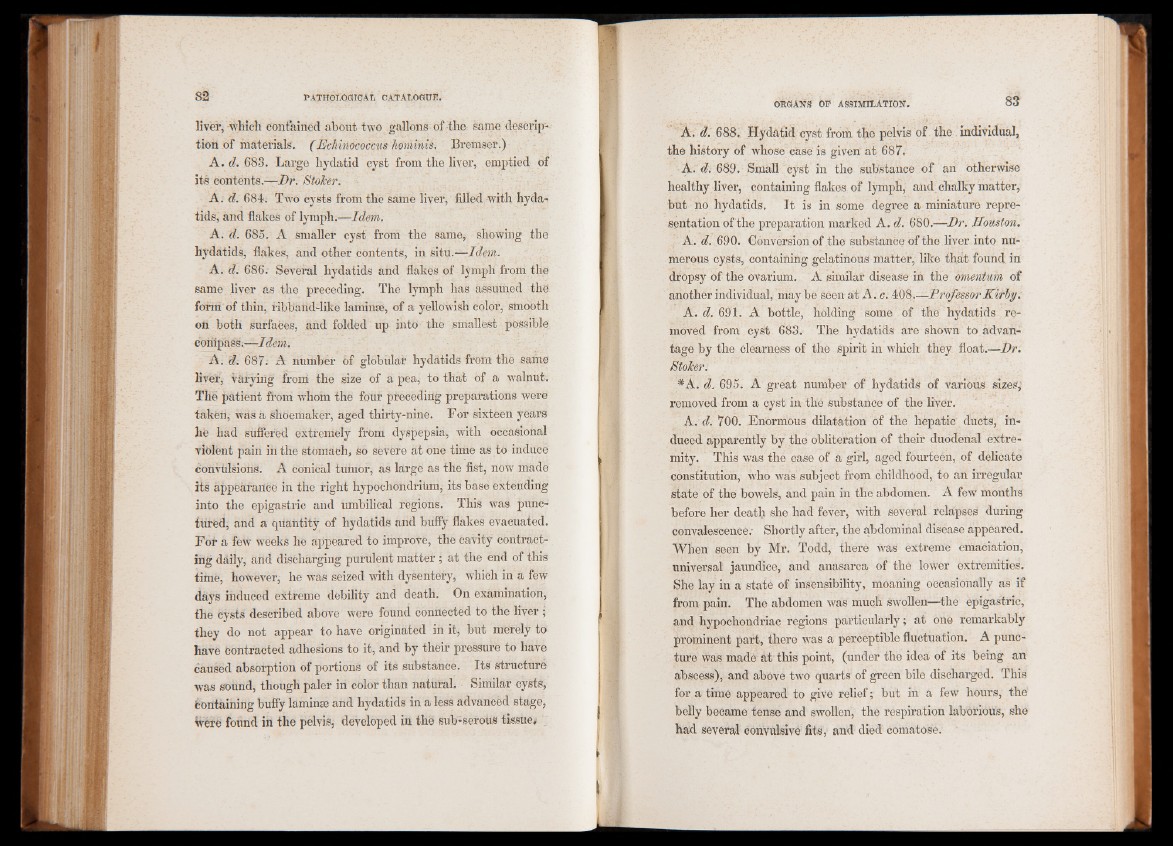
liver,-which contained about two gallons of the same description
of materials. (Echinococcus hominis. Bremser.)
A. d. 683. Large hydatid cyst from the liver, emptied of
its contents.—Dr. Stoker.
A. d. 684. Two cysts from the same liver, filled with hyda-
tidsj and flakes of lymph.—Idem.
A. d. 685. A smaller cyst from the same, showing the
hydatids, flakes, and other contents, in situ.-—Idem.
A. d. 686. Several hydatids and flakes of lymph from the
same liver as the preceding. Thé lymph has assumed the"
form of thin, ribband-like lamime, of a yellowish color, smooth
oh both surfaces, and folded up into the smallest possible
coifipass.—Idem.
A. d. 687. A number of globular hydatids from the same
liver, varying from the size of a pea, to that of a walnut.
The patient from whom the four preceding preparations were
taken, was a shoemaker, aged thirty-nine. For sixteen years
he had suffered extremely from dyspepsia, with occasional
violent pain in the stomach, so severe at one time as to induce
convulsions. A conical tumor, as large as the fist, now made
its appearance in the right hypochondriüm, its base extending
into the epigastric and umbilical regions. This was punctured,
and a quantity of hydatids and buflfy flakes evacuated.
Fof a few weeks he appeared to improve, the cavity contracting
daily, and discharging purulent matter; at the end of this
time, however, he was seized with dysentery, which in a few
days induced extreme debility and death. On examination,
the cysts described above were found connected to the liver ;
they do not appear to have originated in it, but merely to
have Contracted adhesions to it, and by their pressure to have
caused absorption of portions of its substance. Its structure
was sound, though paler in color than natural. Similar cysts,
Containing bufly laminae and hydatids in a less advancèd stage,
Were found in the pelvis, developed in the sub-serous tissue#
A. d. 688. Hydatid cyst from the pelvis of the individual,
the history of whose case is given at 687,
A. d. 689. Small cyst in the substance of an otherwise
healthy liver, containing flakes of lymph, and chalky matter,
but no hydatids. It is in some degree a miniature representation
of the preparation marked A. d. 680.—Dr. Houston.
A. d. 690. Conversion of the substance of the liver into numerous
cysts, containing gelatinous matter, like that found in
dropsy of the ovarium. A similar disease in the omentum of
another individual, maybe seen at A. c. 408.—Professor Kirby.
A. d. 691. A bottle, holding some of the hydatids removed
from cySt 683. The hydatids are shown to advantage
by the clearness of the spirit in which they float.—Dr.
Stoker.
*A. d. 695. A great number of hydatids of various sizes,
removed from a cyst in the substance of the liver.
A. d. TOO. Enormous dilatation of the hepatic ducts, induced
apparently by the obliteration of their duodenal extremity.
This was the case of a girl, aged fourteen, of delicate
constitution, who was subject from childhood, to an irregular
state of the bowels, and pain in the abdomen. A few months
before her death she had fever, with several relapses during
convalescence.- Shortly after, the abdominal disease appeared.
When seen by Mr. Todd, there Was extreme emaciation,
universal jaundice, and anasarca of the lower extremities.
She lay in a state of insensibility, moaning occasionally as if
from pain. The abdomen was much Swollen—the epigastric,
and hypochondriac regions particularly; at one remarkably
prominent part, there was a perceptible fluctuation. A puncture
was made at this point, (under the idea of its being an
abscess), and above two quarts of green bile discharged. This
for a time appeared to give relief; but in a few hours, the
belly became tense and swollen, the respiration laborious, she
had several convulsive fits, and died comatose.